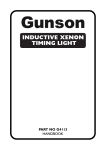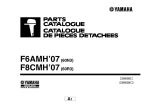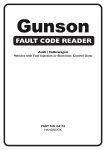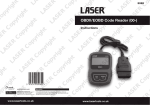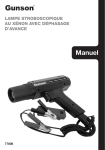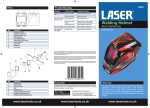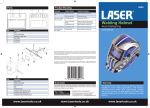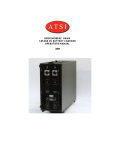Download POCKETMETER 2 - Machine Mart
Transcript
POCKETMETER 2 DIGITAL "General Purpose" MULTIMETER with HOLD LAST READING and TEMPERATURE PART NO G4143 HANDBOOK Gunson Timestrobe POCKETMETER 2 DIGITAL "General Purpose" MULTIMETER with HOLD LAST READING and TEMPERATURE INDEX Page 1 2 3 4 5 6 7 8 9 10 11 12 13 INTRODUCTION 2 DESCRIPTION 3 PRECAUTIONS 4 VOLTAGE 5 CURRENT 7 RESISTANCE 8 CONTINUITY TEST 8 DIODE TEST 9 TRANSISTOR TESTING FACILITY 9 THERMOMETER FACILITY (where applicable). 10 CIRCUIT PROTECTION 10 SPECIFICATION 11 WARRANTY 12 The 10 Amp circuit of this meter is un-fused. Overloading will cause serious damage and invalidate the warranty 1 Gunson Timestrobe 1. INTRODUCTION Pocketmeter2 is a pocket size multimeter which can be used for many applications around the home and in motor vehicle maintenance. The massive growth in popularity of electrical and electronic equipment over recent years has created a requirement for test devices. These have also advanced considerably in the range of facilities offered and of relatively low complexity and correspondingly low cost. This handbook assumes that the user has a reasonable understanding of basic electrical terms VOLTS, AMPS and OHMS, and how these units are related. Without this basic understanding of the fundamentals of electrics, a user will have difficulty in interpreting the measurements. Similarly the user should have some knowledge of the equipment being serviced/repaired in order to use this product effectively. Gunson can accept no responsibility for incorrect diagnosis of faults, or consequential damage occasioned by the use of this product. A helpline exists for technical enquiries regarding Gunson products Tel: 01926 818181 This equipment bears the CE mark indicating that it complies with European Low Voltage Directives including Electro Magnetic Compatibility. This ensures that the equipment does not emit excessive interference and is not adversely affected by interference of a level defined by the regulations. However some circuits e.g. Brush motors, Spark ignition systems, may generate excessive electrical noise and / or emit high levels of interference. Levels will generally be at their greatest, very close to the circuit and will also be increased by poor connections or faulty components. Intense interference may effect test equipment together with other electrical items such as radio or television receivers, computers etc. Interference is likely to be increased just by making electrical connections to the circuit and the user is therefore advised that testing should be undertaken with due care and not in an area close to sensitive electronic equipment. The user should ensure that the meter is being used according to the instructions and that a reasonable measurement is being attempted. If the display behaves in an erratic nature either a rapidly fluctuating signal is being measured or excessive interference is present. The user is advised to read the safety precautions on Pages 4 and 5 before commencing work. 2 Gunson Timestrobe 2. DESCRIPTION (a) DISPLAY Pocketmeter2 has a Liquid Crystal Display (LCD), showing 32 digits (ie maximum scale reading 1999, minimum scale reading -1999). Over-range is indicated by 1, and zero by 000. The battery symbol is illuminated when the internal battery of Pocketmeter needs replacing. (b) FUNCTION SWITCH This is used to select the appropriate function. Ensure that the switch is restored to the "OFF" position after use. In the OFF position, no current is drawn from the battery, which preserves the life of the battery. In the centre of this switch is a button, which if pressed once, retains the present reading in “ HOLD” until it is pressed a second time, when the display reverts to its normal changing appearance. (c) LEADS AND PROBES Two Leads are provided, each fitted with Red or Black Probes and a Temperature Probe (details of how to use this are give in Section 10). In use, the BLACK LEAD is always connected to the bottom socket marked "COM" (which is an abbreviation of COMMON). The RED LEAD is connected to the middle socket (marked "V ø mA or V ø mA °C ") for all ranges except 0 - 10 Amps. For 0 - 10 Amps only the RED LEAD is connected to the far left-hand socket. The probes must always be removed from the circuit being tested if the case is to be opened, e.g. for changing the battery or fuse. (d) BATTERY 9 VOLT, type PP3 or equivalent. If the meter is not to be used for a lengthy period, or if the battery is not in good condition it should be removed to avoid damage by leakage of battery fluids. The battery symbol or "BATT" appears in the display, when the battery voltage has fallen to approximately 7.5 volts. To fit or replace the battery, remove the 2 screws, under the small rubber feet and carefully take off the back of the case). The battery and fuse compartment are then exposed. Fit the battery using the snap connector. Refit the back carefully and do not over-tighten the screws. (e) FUSE The fuse is only used during current measurement on the 0 - 200 mA range. On other ranges, Pocketmeter may be used with no fuse fitted. To replace the fuse, remove the back of the instrument as described above. Use only high quality fuses rated at 500mA. To test a fuse, use the CONTINUITY test. The 0 - 10 Amp range is not protected by a fuse. Care must be taken to avoid damage to the instrument. Such damage is not covered by the warranty. 3 Gunson Timestrobe 3. SAFETY PRECAUTIONS While working with electrical measurement & test equipment be aware that: Testing of household and work-place electrical supplies is hazardous and should be undertaken only by an experienced or qualified electrician. Ensure that you have sufficient understanding of any equipment you are servicing as well as the equipment you are using. Even low voltage equipment can generate high voltages internally using transformers and electronic circuits. Electrical supplies over 40 Volts are potentially hazardous as are all supplies which are capable of delivering a high current. High voltage produces a risk of electric shock and high current in a conductor or component produces risk to eyesight as well as the risk of burns. Circuit breakers and fuses only offer limited protection. Use approved eye protection where appropriate. Where appropriate seek advice and follow the guidance of a suitable publication. Keep children, pets and others who do not appreciate the hazards well away from the work area. While working on a vehicle be aware that: Testing of vehicles is potentially hazardous. Take every precaution to avoid injury and ensure that you have sufficient understanding of the task being undertaken. Seek advice or follow the guidance of a comprehensive vehicle manual. Always follow vehicle manufacturer's warnings, cautions and service procedures. Using this product can involve working on a car while the engine is running. This is a potential hazard and the user should take every precaution to avoid any possibility of damage or injury. Never wear loose clothing that can catch in moving engine parts and always tie-up or cover long hair. Do as much of the work as possible with the engine not running. Always operate the vehicle in a well ventilated area. Do not inhale exhaust gases - they are very poisonous. Always make sure the vehicle is in park (Automatic transmission) or neutral (manual transmission) and that the parking brake is firmly set. Always keep yourself, tools and test equipment away from all moving or hot engine parts, remember that thermostatically controlled fans may suddenly start with no warning. Treat high tension ignition components with respect, remembering that electrical shocks can cause involuntary movement which may result in secondary injury. Never lay tools on a vehicle battery. You may short the terminals together causing harm to yourself, the tools or the battery. When carrying out tests on a motor vehicle, remember that you should NEVER run the engine with the car battery disconnected (either + or -) since the alternator would then run at a damaging over-voltage. Never smoke or have open flames near the vehicle. Vapours from gasoline and a charging battery are highly flammable and explosive. Always keep a suitable fire extinguisher handy. Always turn ignition key OFF when connecting or disconnecting electrical components, unless otherwise instructed. Never leave vehicle unattended while running tests. If for any reason the car is jacked up or the wheels removed, always ensure that the car is well 4 Gunson Timestrobe supported, and never rely on a car jack alone: always also use ramps or axle stands. Be wary of axle stands and jacks sinking into soft ground While working with this product be aware that: Electrical meters and leads should be kept well away from HT voltages, such as spark plug leads, do not make any electrical connection to HT voltages. Remember that Low Tension Voltage, present on the LT terminal of the ignition coil (and at contact breakers), can also give peaks of several hundred volts. This is sufficient to cause malfunction of this and other test equipment on some ranges. Only make connections as advised in the equipment manual. Before connecting the leads of Pocketmeter always ensure that the function switch is switched to the appropriate range for its intended use. This avoids any personal hazard, the possibility of damaging Pocketmeter or damaging the circuit that is being tested. Particular care needs to be taken when the leads are to be connected to a high voltage (eg domestic mains) or high current source (eg across the terminals of a car battery). The meter functions that are the most vulnerable are AMPS, OHMS, CONTINUITY and DIODE. When set at OHMS, CONTINUITY and DIODE, all test meters produce a voltage at their input leads. This may be enough to damage certain very sensitive components if the user was intending to measure, for example, millivolts in a working electronic circuit. After using Pocketmeter, first disconnect the leads from the circuit being tested, then set the FUNCTION switch to the OFF position. Doing things in this order ensures protection of Pocketmeter and the circuits being measured, and also preserves the life of Pocketmeter's internal battery. CAUTION: You are strongly advised not to use this meter for testing of Safety Air Bags. You must follow vehicle service manual cautions when working around the air bag components or wiring. If the cautions are not followed, the air bag may open up unexpectedly, resulting in personal injury. Note: The air bag may still open up several minutes after the ignition key is off (or even if the vehicle battery is disconnected) because of a special energy reserve module. 4. VOLTAGE Pocketmeter has 7 ranges for measuring voltage, selected by the central FUNCTION switch. 5 are for measuring DC volts (V -)(i.e. constant voltages associated with "Direct Current"), and 2 for measuring AC volts (V-). The particular ranges are as follows: 0 0 0 0 0 0 0 to to to to to to to 200 mV DC 2 V DC 20 V DC 200 V DC 500 V DC 200 V AC 500 V AC (ie 0 to 0.200 V) (ie "Alternating" voltages) The 0 to 2 and 0 to 20 V ranges will be found the most useful in 12V motor vehicles. The 200 V range will be found of use in 24 V vehicles (not because 24V vehicles have particularly high voltages, but simply because 24 V is above the 0 to 20V range). The 0 - 200 and 750 VAC ranges are provided for measuring domestic mains voltage. They can 5 Gunson Timestrobe be used for supplies at 50 and 60 Hz, and 110V and 250VAC respectively. Great care should be exercised in making any high voltage measurements, ie measurements made using the 0 to 200V DC range, or the 0 to 750V AC range, because of the potentially serious consequences of high voltage shocks to the user. When measuring high voltages, such as domestic mains voltage, great care should be taken to avoid electric shock. All DC voltage ranges have a very high internal impedance (about 1 meg-ohms), which means that Pocketmeter draws a negligibly small current from the circuit being tested. Therefore the circuit is not affected by connecting Pocketmeter to it, and Pocketmeter can be used on sensitive electronic circuits. This high internal impedance of Pocketmeter also provides protection to Pocketmeter. On VOLTS AC, the internal impedance (resistive) is 450 K-ohms. Measuring voltage is a simple matter, the probes of the meter are simply touched on the two points of the circuit which are of interest, and between which the voltage is to be measured. That is, voltage measurements are always made with the leads connected IN PARALLEL with the circuit or component being tested. INSTRUCTIONS FOR USE (VOLTAGES BELOW 20 V DC OR AC) (a) Set the central FUNCTION switch to the appropriate voltage range (V DC) or V AC). Set to a high range initially. The range can be switched lower if greater accuracy is required. (b) Fit the RED and BLACK leads to the middle (V) and COM sockets. Touch the RED and BLACK leads across the circuit or component to be tested. RED should be connected to the positive side, and BLACK to the negative side for DC measurements. (c) Observe the reading on the display. If the connections have been made the wrong way round Pocketmeter will simply show a minus sign in front of the reading (DC measurements). (d) After use, disconnect the leads from the circuit being measured BEFORE returning the FUNCTION switch to the OFF position. (NEVER rotate the FUNCTION switch through OHMS or AMPS position with the leads connected to a LIVE voltage). INSTRUCTIONS FOR USE (VOLTAGES ABOVE 20 V, INCLUDING 230 or 110 V AC). High voltages are dangerous, and mains electric shocks can be fatal. For use in measurement of high voltages, follow the instructions for voltage measurements above, but take particular care to avoid any possibility of electric shocks. Make all contacts with live parts using the insulated probes, keeping fingers well away from the exposed metal parts of the probes. The user should ensure that the leads are well plugged into the sockets, and that the leads are not chafed or damaged, and that the case of Pocketmeter has not been cracked or damaged. Needless to say, such measurements should not be made while the case of Pocketmeter is open. Note that if high voltages, including main supply voltages, are applied to Pocketmeter while the Function switch is set to CONTINUITY, DIODE, or any of the OHMS ranges, there is the possibility of meter circuit damage. Such misuse voids The Tool Connection 6 Gunson Timestrobe 5. CURRENT (DC ) Centre Socket 0 to 2000 uA 0 to 20 mA 0 to 200 mA 0 to 200 uA (excluded on some models). Left-hand Socket 0 to 10A Pocketmeter has 5 current (Amps, A ) ranges, measuring DC electrical current in the range 0 - 10 A. This is intended for current measurement of low voltage apparatus, such as many motor car circuits, and domestic battery powered equipment. It should NOT be used to attempt to measure current in high voltage equipment and the meter will not indicate AC current. Warning: incorrect connection to an AC mains supply is extremely hazardous Measurements of electrical current are always made with the leads connected IN SERIES with the circuit or component being tested, that is, the circuit to be tested is broken, and the Pocketmeter is included in the circuit. Therefore the flow of electrical current that was flowing through the circuit is now diverted through the Pocketmeter, and back into the circuit again. The current range of Pocketmeter has a very small resistance, so that the instrument may be used to measure a flow of current without providing any significant resistance to that current. The need for Pocketmeter (and any ammeter) to have a low internal resistance renders such instrument vulnerable to damage, should the user inadvertently connect them to high current supplies, since there is effectively a "dead short" across the instrument. For this reason, Pocketmeter includes a fuse which limits the current to 500 mA. (Inadvertent connection to a higher current source, while the switch is set to milliamps, will immediately blow this fuse). The 0 -10 Amp range is unprotected by a fuse, so care must be taken to avoid damage. INSTRUCTIONS FOR USE - when measuring DC current (a) Set the central FUNCTION switch to 10 AMPS. (b) Switch off the current of the circuit to be tested and break the circuit at a suitable point. (c) Fit the BLACK LEAD to the socket marked COMM and the RED LEAD to the top RED socket marked 10 A. If the current proves to be NOT MORE THAN 200mA (0.2 A), then the RED LEAD can be replaced in the middle RED socket for the other ranges and the function switch set appropriately, for more accurate readings. (d) Touch the RED and BLACK probes of Pocketmeter to the circuit to be tested, RED to the positive side, and BLACK to the negative side. (e) Switch on the current of the circuit to be tested and observe the reading. (See Description, item 2(f) for fuse testing and replacement, if the meter fails to give a reading on the 0 - 200 mA range). (f) After use, switch off the current in the circuit that is being tested, disconnect Pocketmeter, remove the RED lead, return the FUNCTION switch to the OFF position, and restore the connections of the circuit that has been tested. 7 Gunson Timestrobe 6.RESISTANCE Pocketmeter has 5 resistance (Ohms ø) ranges, selected by the central FUNCTION switch, as follows: 0 0 0 0 0 to to to to to 200 Ohms 2K Ohms 20K Ohms 200K Ohms 2M Ohms (ie (ie (ie (ie 0 0 0 0 to to to to 2000 Ohms) 20,000 Ohms) 200,000 Ohms) 2,000,000 Ohms) These ranges are used for measurements of resistance where the resistance of particular components are known from a data manual or a vehicle technical handbook. For instance, the 0 to 200 Ohm range is valuable for testing parts of the ignition Low Tension (LT) circuit on a vehicle, the 0 to 200K Ohm range for testing parts of the ignition High Tension (HT) circuit (such as plug leads), and the other ranges for testing particular circuit elements, sensors etc. The 0 to 20M Ohm range is particularly useful for testing insulation. When measuring resistance, Pocketmeter passes a very small electrical current through the circuit/component being tested. It is therefore essential that the circuit/component being tested is electrically "dead" (ie is disconnected from any electrical supply). Otherwise, Pocketmeter may be damaged. Some internal protection is provided, but it is good practice not to put it to the test. In any case, readings taken on a circuit that is not electrically "dead" will be meaningless. Because current is drawn from the internal battery for resistance tests, any tests made, particularly on the lowest range, 0 - 200 Ohms, should be brief so as to minimise the current drawn from the internal battery (this proviso also applies to "Continuity" and "Diode" tests, which follow). INSTRUCTIONS FOR USE - when measuring resistance (a) Ensure that the circuit/component to be tested is electrically "dead", ie is not connected to any electrical supply. (b) Set the central FUNCTION switch to a resistance range Touch the RED and BLACK PROBES to the circuit/component to be tested. (c) Observe the reading on the display. If the over-range indication is displayed (1___.), turn the switch to a higher resistance range (this may be done without disconnecting the leads). (d) After use, disconnect the leads from the circuit/component, and return the FUNCTION switch to the "OFF" position. 7. CONTINUITY TEST The "Continuity" function is used to measure whether wiring is "continuous", or whether it has a break. The circuit to be tested needs to be electrically isolated i.e. "dead" for this test to be carried out. To use the Continuity Test, simply set the central switch to CONTINUITY, and touch the probes at either end of the wiring to be tested. 8 Gunson Timestrobe If the wiring is continuous, then the display will show "000" (and a bleep will sound, where fitted). If there is a break in the wiring, the display will indicate over-range 1___ (and there will be no bleep). (NOTE: The Continuity bleep actually tests whether the resistance of the wiring is above a threshold of around 70 Ohms). 8. DIODE TEST A diode is a device which conducts electricity in one direction (referred to as the "forward" direction), but acts as an insulator in the other direction (the "reverse" direction). In the forward direction, diodes exhibit a volt drop which varies between 0.3V and 0.8V. Diodes which have failed generally either conduct in both directions, or act as insulators in both directions. When set at DIODE test, Pocketmeter applies a voltage of around 2.4 V, to a diode, and the display shows the approximate volt drop across the diode in millivolts. To use Pocketmeter to test a diode, set the function switch to DIODE, and touch the probes to the diode, first one way round, then the other way round. In the forward direction the reading should be between 300 and 800, in the reverse direction the diode should read over-range, 1___. 9. TRANSISTOR TESTING FACILITY To test the gain (hFE) of small signal transistors (out of circuit), the transistor leads may be plugged directly into the circular socket (to the lower left of the function switch) on the meter front panel. To test larger transistors with heavy leads, fuse wire or similar should be soldered to the transistor leads to avoid straining the socket. Note that the test current is small in order to protect the device under test against damage due to overload or misconnection. The reading may therefore be higher than expected particularly for larger devices and power transistors. The test will provide a reasonable test of component function or fault. INSTRUCTIONS - for Transistor testing. 1. The transistor to be tested should be identified to establish its type - NPN or PNP. The base collector and emitter connections should then be noted so that connections can be made according to the socket indications. (Some experiment is possible if these are unknown until a sensible indication is achieved). 2. Remove the meter test leads as these are not used for this test. Switch the meter function switch to the transistor test range (hFE). 3. Insert the transistor into the socket as described and read the indicated value for gain (hFE) from the display. Expect values of 50 for a power transistor to 500 for a small signal transistor. These values are an approximate guide only. If an off-scale or unreasonable reading is observed check the connections and revise as required. 4. An off scale or zero reading indicates a faulty component 9 Gunson Timestrobe 10. MULTIMETER WITH THERMOMETER FACILITY Temperature measurement is available on those instruments equipped with a probe and having a separate switched temperature function. The normal test probes should not be fitted in the instrument during this test. NOTE: the insulation on the leads should not be subjected to temperatures above 100 degrees centigrade. For probe tip maximum see specification The instrument will read ambient or room temperature without a probe fitted. Rate of change to a new temperature is not as rapid as with an external probe. WARNING - Take care of high temperatures particularly with hot fluids. Cooling systems for example on motor vehicles are pressurised and may instantly boil if the pressure is released! INSTRUCTIONS - for temperature measurement with a probe. 1. Switch the meter to the temperature (TEMP) measurement range 2. Insert the plugs from the temperature probe into the two lower meter sockets, observing the colour coded polarity of the leads. 3. Place the probe in the position where temperature is to be measured. Note it will be necessary to enclose the probe tip for measuring the temperature of an object accurately (if the object temperature is different from its surroundings). Submerge the probe tip to approximately one half of its length to ensure accuracy in fluids. 11. CIRCUIT PROTECTION 1. Forward and reverse Voltage limits. The instrument is fully protected against internal damage due to inadvertent forward or reverse polarity connection of the V ø mA (T) and COMM sockets to up to 1000 V AC or DC when the function switch is set to: VOLTS range. When the function switch is set to other ranges, only short term protection is provided at high voltages. On the MILLIAMPS setting, protection is provided by a 500 mA fuse. NO FUSE IS PROVIDED ON THE 10 AMP range, therefore care should be exercised when measurements are made on high power circuits and circuits which may be damaged by a low resistance short circuit (current ranges require a low meter resistance). 2. High Tension Ignition - on a vehicle. On no account must any lead of the instrument be connected to the high tension (HT) circuit. The warranty is voided by exposing the leads or circuits of Pocketmeter to HT voltages. 3. Mains Voltage On no account must the instrument be connected to domestic mains voltage, except when the function switch is set to the Voltage ranges. Set to VAC 750 V range (in the UK and other countries with 230 AC V supply) or the AC 200 V range (in other countries with 110 AC V supply). The warranty is voided by incorrect connection of Pocketmeter to mains voltage and there is danger of personal injury / damage. 4.Internal Battery Pocketmeter will not be damaged by reverse connection of the internal (9V) battery. 5. Internal ECU voltage measurements Some motor vehicle manufacturers recommend that only 10 Gunson Timestrobe digital multimeters should be used for voltage measurements of the internal circuitry of certain engine managements systems (ECU's), and that such instruments should have an impedance on the voltage range of at least 10 M Ohms. Pocketmeter does not comply with this requirement, but measurement of ECU sensors is permissible as these are external to the ECU and circuit protection is more substantial. 12. SPECIFICATION VOLTS VOLTS VOLTS VOLTS VOLTS DC: DC: DC: DC: DC: 0 0 0 0 0 200mV 2V 20V 200V - 1000V Accuracy Accuracy Accuracy Accuracy Accuracy + 0.5% + 2 digits + 0.5% + 2 digits + 0.8% + 2 digits + 0.5% + 2 digits +-0.8% +-2 digits VOLTS AC: 0 200V VOLTS AC: 0 - 750 V Accuracy + 1.2% + 2 digits Accuracy +-1.2% +-10 digits AMPS AMPS AMPS AMPS AMPS Accuracy Accuracy Accuracy Accuracy Accuracy +-1.0% +-2 digits +-1.0% +-2 digits +-1.0% +-2 digits +-1.2% +-2 digits + 2.0% + 2 digits Accuracy Accuracy Accuracy Accuracy Accuracy + + + + + DC: DC: DC: DC: DC: 200 uA 2000 uA 20 mA 200 mA 0 10A RESISTANCE: RESISTANCE: RESISTANCE: RESISTANCE: RESISTANCE: 0 0 0 0 0 200 Ohm 2K Ohm 20K Ohm 200K Ohm 2M Ohm 0.8% 0.8% 0.8% 0.8% 0.1% + + + + + 2 2 2 2 2 Impedance Impedance Impedance Impedance Impedance 1 1 1 1 1 Meg Meg Meg Meg Meg Ohm Ohm Ohm Ohm Ohm digits Digits Digits Digits Digits DIODE TEST: 0 2400 mV CONTINUITY TEST: Test threshold 70 Ohms Visual indication (and Audible where fitted). TEMPERATURE RANGE (where applicable) -40 C to +1000 C BATTERY: 9v (PP3) FUSE: 500 mA 11 Gunson Timestrobe 13. Warranty This warranty is in addition to the statutory rights of the purchaser. The Tool Connection has made every effort to ensure that this product is of the highest quality and value to the customer. However, The Tool Connection can accept no responsibility for consequential damage howsoever caused arising from the use of this product. All technical enquiries regarding this product should be made to: Telephone 01926 818181. If this product should require service or repair, it should be returned to: The Tool Connection Limited, Kineton Road, Southam, Warwickshire CV47 0DR When sending goods for service or repair, please give full details of faults requiring attention. 12 Gunson Timestrobe 13
















